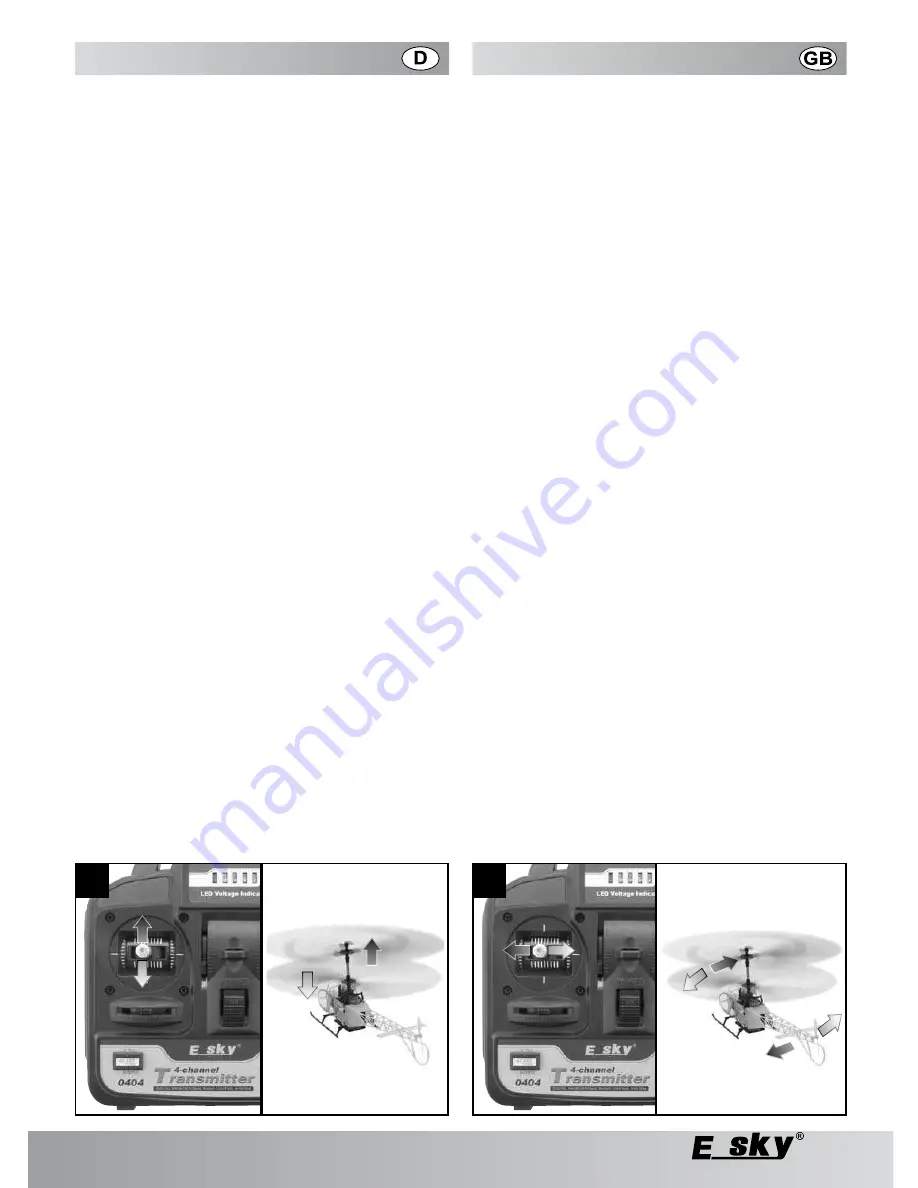
09/08
32
Control functions
Pitch Function (16)
The flight height of a helicopter is affected by the pitch function.
The control is effected with the left control stick. To that effect,
the control stick can be moved forward and backward. Unlike
with other control functions, .the stick does not keep springing
back to the centre position.
As the angles of attack of the rotor blades are not modifiable,
setting the flying height is effected via a common speed modifi-
cation of the two rotors.
Pulling the control stick towards you switches off the motors and
the rotors stop.
If you push the control stick forward, the rotors run and increase
the speed according to the position of the stick.
When the control stick reaches the center position, the helicopter
should hover.
Tail Function (17)
As the helicopter is equipped with two counter-rotating rotors,
there is no torque around the yaw axis (rotor shaft). The heli-
copter does not need a tail rotor for stabilization.
To allow the model to turn around the yaw axis (rotor shaft), the
rotors run with slightly different speeds and the model begins
to turn.
The control of the tail function is effected with the left control stick
also. If the stick is steered slightly towards the left, the tip of the
fuselage turns towards the left.
If you steer towards the right, the tip of the fuselage turns likewi-
se towards the right.
Roll Function (18)
The roll function allows you to move your model helicopter side-
ways to the right and to the left. The control is effected with the
right control stick.
If the stick is steered slightly towards the left, the model drifts
sideways to the left.
If you steer to the right, the model drifts sideways to the right.
Nick Function (19)
With the help of the nick function you can move the model heli-
copter forward and backward. The control is effected likewise
with the right control stick.
If you press the stick slightly forward, the model flies forward.
If you pull the stick towards the back, the model flies back-
wards.
Steuerfunktionen
Pitch-Funktion (16)
Mit Hilfe der Pitch-Funktion wird die Flughöhe eines Helikopters
beeinflusst. Die Steuerung erfolgt mit dem linken Steuerknüppel.
Dazu kann dieser nach vorne und hinten bewegt werden, ohne
dass er, wie bei den restlichen Steuerfunktionen, immer wieder
in die Mittelstellung zurückfedert.
Da die Anstellwinkel der Rotorblätter nicht veränderbar sind,
erfolgt die Regulierung der Flughöhe über eine gemeinsame
Drehzahländerung der beiden Rotoren.
Ist der Steuerknüppel ganz zum Körper gezogen, sind die
Motoren aus und die Rotoren stehen.
Wenn der Steuerknüppel nach vorne geschoben wird, laufen die
Rotoren an und erhöhen je nach Knüppelstellung die Drehzahl.
Ist die Mittelstellung des Steuerknüppels erreicht, sollte der
Helikopter schweben.
Heck-Funktion (17)
Da der Modellhelikopter zwei gegenläufige Rotoren besitzt, ent-
steht auch kein Drehmoment um die Hochachse (Rotorwelle).
Der Helikopter braucht demzufolge keinen Heckrotor zur
Stabilisierung.
Um das Modell um die Hochachse (Rotorwelle) drehen zu kön-
nen, laufen die Rotoren mit leicht unterschiedlichen Drehzahlen
und schon beginnt das Modell sich zu drehen.
Die Steuerung der Heck-Funktion erfolgt ebenfalls mit dem
linken Steuerknüppel. Wird der Knüppel leicht nach links gesteu-
ert, dreht sich die Rumpfspitze nach links.
Steuern Sie nach rechts, dreht sich die Rumpfspitze ebenfalls
nach rechts.
Roll-Funktion (18)
Mit Hilfe der Roll-Funktion können Sie den Modellhelikopter
seitlich nach rechts und links bewegen. Die Steuerung erfolgt mit
dem rechten Steuerknüppel.
Wird der Knüppel leicht nach links gesteuert, driftet das Modell
seitlich nach links.
Steuern Sie nach rechts, so driftet das Modell seitlich nach
rechts
Nick-Funktion (19)
Mit Hilfe der Nickfunktion können Sie den Modellhelikopter nach
vorne und nach hinten bewegen. Die Steuerung erfolgt ebenfalls
mit dem rechten Steuerknüppel.
Wird der Knüppel leicht nach vorne gedrückt, fliegt das Modell
nach vorne.
Ziehen Sie den Knüppel nach hinten, fliegt das Modell rück-
wärts.
16
17
















































